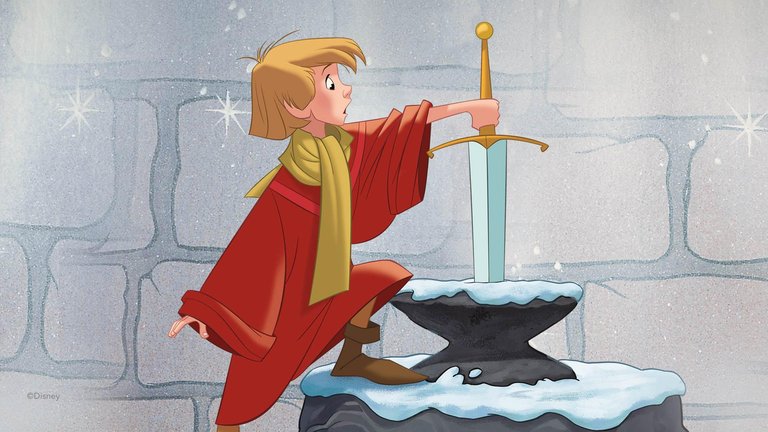Film Review: The Sword in the Stone (1963)

The Arthurian legends have captivated audiences for centuries, inspiring a vast array of literary, artistic, and musical works. This enduring fascination has naturally led to the production of numerous films, each attempting to capture the essence of these timeless tales. However, with such a large body of work, the quality of adaptations has varied significantly; some films fail to live up to their potential. This is particularly true for Walt Disney's 1963 animated feature, The Sword in the Stone, which is often regarded as one of the lesser entries in Disney's illustrious catalogue of animated classics.
Based on T. H. White's 1938 novel of the same name, The Sword in the Stone is the first part of White's celebrated series The Once and Future King. This seminal work has had a profound impact on Arthurian literature and culture, influencing not only literature but also stage productions, most notably the popular Broadway musical Camelot.
Set in a mythical version of medieval England, the film opens in a time of chaos following the death of King Uther Pendragon. With no clear heir to the throne, the country descends into anarchy and violence. A prophecy foretells that only he who can pull the legendary sword Excalibur from its anvil shall become king. Many have tried and failed, leading to a general forgetfulness about the sword's significance. By the time the plot unfolds, a tournament in London is set to determine the new king, with Sir Ector (voiced by Sebastian Cabot) hoping his son Sir Kay (voiced by Norman Alden) will emerge victorious. Meanwhile, Arthur—affectionately known as "Wart" (voiced by Ricky Sorensen, Richard Reitherman, and Robert Reitherman)—serves as a squire at Sir Ector’s estate. His life takes a fateful turn when he encounters Merlin (voiced by Karl Swenson), an eccentric wizard who possesses knowledge of future events and takes it upon himself to educate Wart.
Disney had initially acquired the filming rights to White's novel in 1938, but the project was put on hold due to the outbreak of World War II and the studio's focus on other ventures. The film spent over two decades in development hell, with Disney finally giving the green light in the early 1960s, inspired by the success of the Camelot. The Sword in the Stone would ultimately become the last animated feature completed during Disney's lifetime.
Directed by Wolfgang Reitherman, a veteran animator at Disney responsible for several acclaimed features during the 1960s and 1970s, The Sword in the Stone exemplifies traditional animation techniques. The film showcases impressive character animation alongside light-hearted humour and catchy songs composed by brothers Robert and Richard Sherman—who would later become legends within Disney’s musical canon.
Despite its charm and entertainment value, The Sword in the Stone falls short when compared to Disney’s more iconic classics. A significant factor contributing to this perception is its script, which prioritises comical misadventures over deeper narrative engagement with Arthurian lore. The sequences where Merlin transforms Wart into various animals—a fish, a squirrel, and a bird—while amusing, feel somewhat disconnected from the gravitas typically associated with Arthurian mythology. The magical duel between Merlin and Madam Mim (voiced by Martha Wentworth) provides an entertaining diversion but lacks any substantial connection to Wart's destiny as king. When Wart finally pulls Excalibur from the anvil in a climactic moment that should resonate with significance, it arrives almost as an afterthought; Merlin is notably absent from this pivotal scene because he has chosen to take a holiday in 20th-century Bermuda. This anti-climactic conclusion feels more like an introduction to a longer saga rather than a satisfying resolution.
These shortcomings did not go unnoticed by contemporary critics; however, The Sword in the Stone achieved considerable commercial success upon its release. This success played a crucial role in maintaining Disney's status as a powerhouse in Hollywood and global animation even after its founder’s passing. While it may not reach the high standards set by some of its predecessors or successors, modern audiences—particularly younger viewers—are likely to find enjoyment in its whimsical storytelling and vibrant animation.
RATING: 6/10 (++)
Blog in Croatian https://draxblog.com
Blog in English https://draxreview.wordpress.com/
InLeo blog https://inleo.io/@drax.leo
Hiveonboard: https://hiveonboard.com?ref=drax
InLeo: https://inleo.io/signup?referral=drax.leo
Rising Star game: https://www.risingstargame.com?referrer=drax
1Inch: https://1inch.exchange/#/r/0x83823d8CCB74F828148258BB4457642124b1328e
BTC donations: 1EWxiMiP6iiG9rger3NuUSd6HByaxQWafG
ETH donations: 0xB305F144323b99e6f8b1d66f5D7DE78B498C32A7
BCH donations: qpvxw0jax79lhmvlgcldkzpqanf03r9cjv8y6gtmk9
Posted Using InLeo Alpha
Congratulations @drax! You have completed the following achievement on the Hive blockchain And have been rewarded with New badge(s)
You can view your badges on your board and compare yourself to others in the Ranking
If you no longer want to receive notifications, reply to this comment with the word
STOPCheck out our last posts: